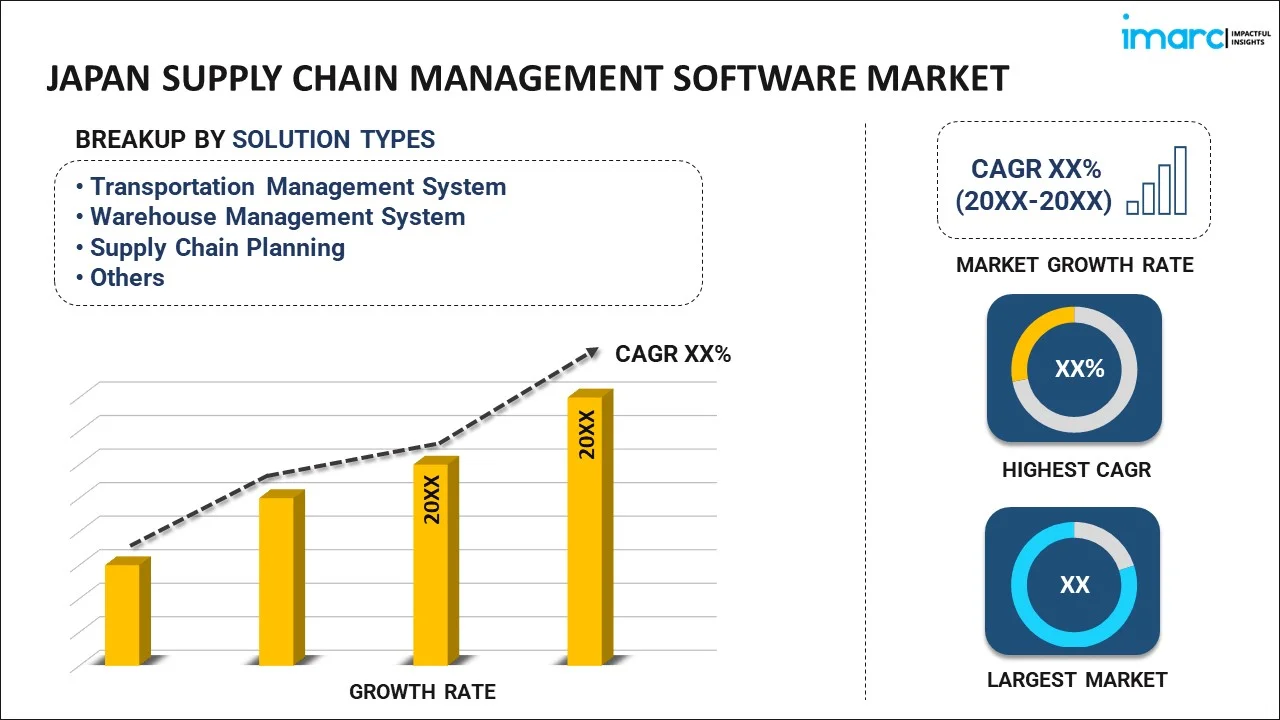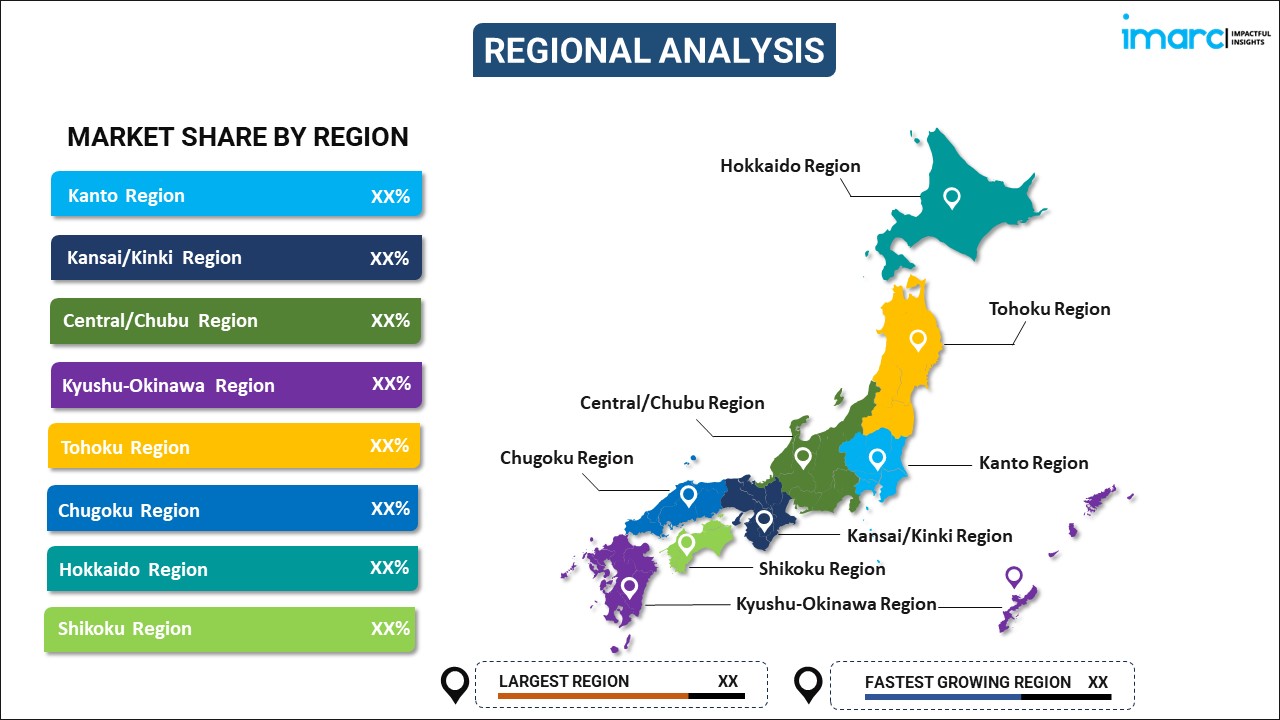
Japan Supply Chain Management Software Market Report by Solution Type (Transportation Management System, Warehouse Management System, Supply Chain Planning, Procurement and Sourcing, Manufacturing Execution System), Deployment Mode (On-premises, Cloud-based), Organization Size (Small and Medium-sized Enterprises, Large Enterprises), Industry Vertical (Retail and Consumer Goods, Healthcare and Pharmaceuticals, Manufacturing, Food and Beverages, Transportation and Logistics, Automotive, and Others), and Region 2025-2033
Market Overview:
Japan supply chain management software market size reached USD 1,153 Million in 2024. Looking forward, IMARC Group expects the market to reach USD 1,580 Million by 2033, exhibiting a growth rate (CAGR) of 3.6% during 2025-2033. The increasing demand for advancements in technologies, such as IoT, AI, and blockchain, which help in enabling greater automation, predictive analytics, and enhanced decision-making capabilities, is primarily driving the market.
|
Report Attribute
|
Key Statistics
|
|---|---|
|
Base Year
|
2024 |
|
Forecast Years
|
2025-2033 |
|
Historical Years
|
2019-2024
|
| Market Size in 2024 | USD 1,153 Million |
| Market Forecast in 2033 | USD 1,580 Million |
| Market Growth Rate (2025-2033) | 3.6% |
Supply chain management software (SCM) is a digital solution that facilitates the planning, execution, and monitoring of all activities involved in the flow of goods, information, and finances across a supply chain. It helps organizations streamline their operations, reduce costs, improve efficiency, and enhance customer satisfaction. SCM software typically includes modules for inventory management, demand forecasting, order processing, supplier relationship management, transportation management, and warehouse management. These modules work together to optimize the procurement, production, and distribution of products. Key benefits of SCM software include better demand visibility, reduced lead times, increased inventory accuracy, and improved decision-making through data analytics and real-time tracking. It also allows for better collaboration among supply chain partners, ensuring smoother operations. In a rapidly evolving business landscape, SCM software plays a crucial role in ensuring companies can adapt to changing market conditions and customer demands while maintaining cost-effectiveness and reliability throughout their supply chains.
Japan Supply Chain Management Software Market Trends:
The supply chain management software market in Japan is witnessing robust growth due to several key drivers. Firstly, the expanding businesses have led to a higher demand for efficient supply chain solutions. Consequently, companies are turning to software to optimize their regional operations, resulting in a surge in market demand. Furthermore, the rapid advancement of technology, including the Internet of Things (IoT) and artificial intelligence (AI), has enabled the development of more sophisticated supply chain management software. As a result, businesses are eager to adopt these cutting-edge solutions to gain a competitive edge. In addition to this, the e-commerce boom has led to a substantial increase in demand for efficient supply chain management. Companies are increasingly focused on meeting customer expectations for fast and accurate deliveries, necessitating the use of advanced software solutions. Lastly, environmental sustainability concerns are pushing companies to adopt software that can optimize their supply chains to reduce carbon footprints. In conclusion, the supply chain management software market in Japan is expected to be driven by growing businesses, technological advancements, e-commerce growth, and sustainability goals.
Japan Supply Chain Management Software Market Segmentation:
IMARC Group provides an analysis of the key trends in each segment of the market, along with forecasts at the country level for 2025-2033. Our report has categorized the market based on solution type, deployment mode, organization size, and industry vertical.
Solution Type Insights:

- Transportation Management System
- Warehouse Management System
- Supply Chain Planning
- Procurement and Sourcing
- Manufacturing Execution System
The report has provided a detailed breakup and analysis of the market based on the solution type. This includes transportation management system, warehouse management system, supply chain planning, procurement and sourcing, and manufacturing execution system.
Deployment Mode Insights:
- On-premises
- Cloud-based
A detailed breakup and analysis of the market based on the deployment mode have also been provided in the report. This includes on-premises and cloud-based.
Organization Size Insights:
- Small and Medium-sized Enterprises
- Large Enterprises
The report has provided a detailed breakup and analysis of the market based on the organization size. This includes small and medium-sized enterprises and large enterprises.
Industry Vertical Insights:
- Retail and Consumer Goods
- Healthcare and Pharmaceuticals
- Manufacturing
- Food and Beverages
- Transportation and Logistics
- Automotive
- Others
A detailed breakup and analysis of the market based on the industry vertical have also been provided in the report. This includes retail and consumer goods, healthcare and pharmaceuticals, manufacturing, food and beverages, transportation and logistics, automotive, and others.
Regional Insights:

- Kanto Region
- Kansai/Kinki Region
- Central/ Chubu Region
- Kyushu-Okinawa Region
- Tohoku Region
- Chugoku Region
- Hokkaido Region
- Shikoku Region
The report has also provided a comprehensive analysis of all the major regional markets, which include Kanto Region, Kansai/Kinki Region, Central/ Chubu Region, Kyushu-Okinawa Region, Tohoku Region, Chugoku Region, Hokkaido Region, and Shikoku Region.
Competitive Landscape:
The market research report has also provided a comprehensive analysis of the competitive landscape. Competitive analysis such as market structure, key player positioning, top winning strategies, competitive dashboard, and company evaluation quadrant has been covered in the report. Also, detailed profiles of all major companies have been provided.
Japan Supply Chain Management Software Market Report Coverage:
| Report Features | Details |
|---|---|
| Base Year of the Analysis | 2024 |
| Historical Period | 2019-2024 |
| Forecast Period | 2025-2033 |
| Units | Million USD |
| Scope of the Report | Exploration of Historical and Forecast Trends, Industry Catalysts and Challenges, Segment-Wise Historical and Predictive Market Assessment:
|
| Solution Types Covered | Transportation Management System, Warehouse Management System, Supply Chain Planning, Procurement and Sourcing, Manufacturing Execution System |
| Deployment Modes Covered | On-premises, Cloud-based |
| Organization Sizes Covered | Small and Medium-sized Enterprises, Large Enterprises |
| Industry Verticals Covered | Retail and Consumer Goods, Healthcare and Pharmaceuticals, Manufacturing, Food and Beverages, Transportation and Logistics, Automotive, Others |
| Regions Covered | Kanto Region, Kansai/Kinki Region, Central/ Chubu Region, Kyushu-Okinawa Region, Tohoku Region, Chugoku Region, Hokkaido Region, Shikoku Region |
| Customization Scope | 10% Free Customization |
| Post-Sale Analyst Support | 10-12 Weeks |
| Delivery Format | PDF and Excel through Email (We can also provide the editable version of the report in PPT/Word format on special request) |
Key Questions Answered in This Report:
- How has the Japan supply chain management software market performed so far and how will it perform in the coming years?
- What has been the impact of COVID-19 on the Japan supply chain management software market?
- What is the breakup of the Japan supply chain management software market on the basis of solution type?
- What is the breakup of the Japan supply chain management software market on the basis of deployment mode?
- What is the breakup of the Japan supply chain management software market on the basis of organization size?
- What is the breakup of the Japan supply chain management software market on the basis of industry vertical?
- What are the various stages in the value chain of the Japan supply chain management software market?
- What are the key driving factors and challenges in the Japan supply chain management software?
- What is the structure of the Japan supply chain management software market and who are the key players?
- What is the degree of competition in the Japan supply chain management software market?
Key Benefits for Stakeholders:
- IMARC’s industry report offers a comprehensive quantitative analysis of various market segments, historical and current market trends, market forecasts, and dynamics of the Japan supply chain management software market from 2019-2033.
- The research report provides the latest information on the market drivers, challenges, and opportunities in the Japan supply chain management software market.
- Porter's five forces analysis assist stakeholders in assessing the impact of new entrants, competitive rivalry, supplier power, buyer power, and the threat of substitution. It helps stakeholders to analyze the level of competition within the Japan supply chain management software industry and its attractiveness.
- Competitive landscape allows stakeholders to understand their competitive environment and provides an insight into the current positions of key players in the market.
Need more help?
- Speak to our experienced analysts for insights on the current market scenarios.
- Include additional segments and countries to customize the report as per your requirement.
- Gain an unparalleled competitive advantage in your domain by understanding how to utilize the report and positively impacting your operations and revenue.
- For further assistance, please connect with our analysts.
 Inquire Before Buying
Inquire Before Buying
 Speak to an Analyst
Speak to an Analyst
 Request Brochure
Request Brochure
 Request Customization
Request Customization




.webp)




.webp)












